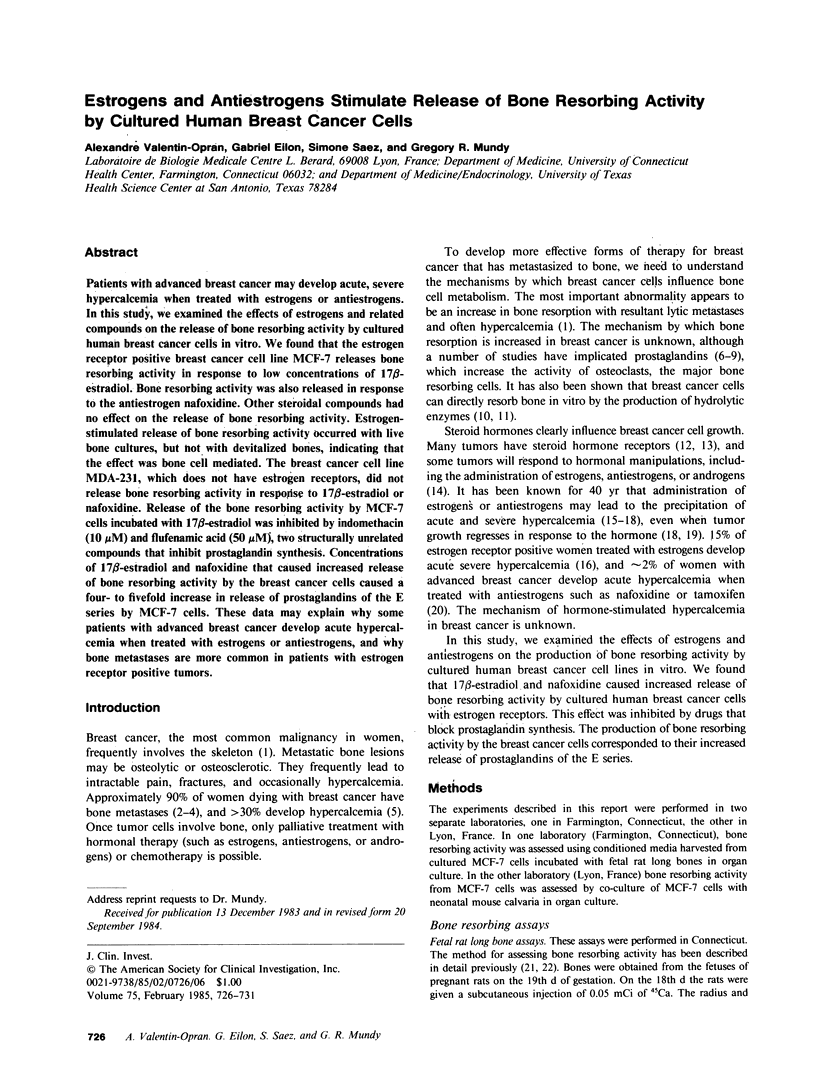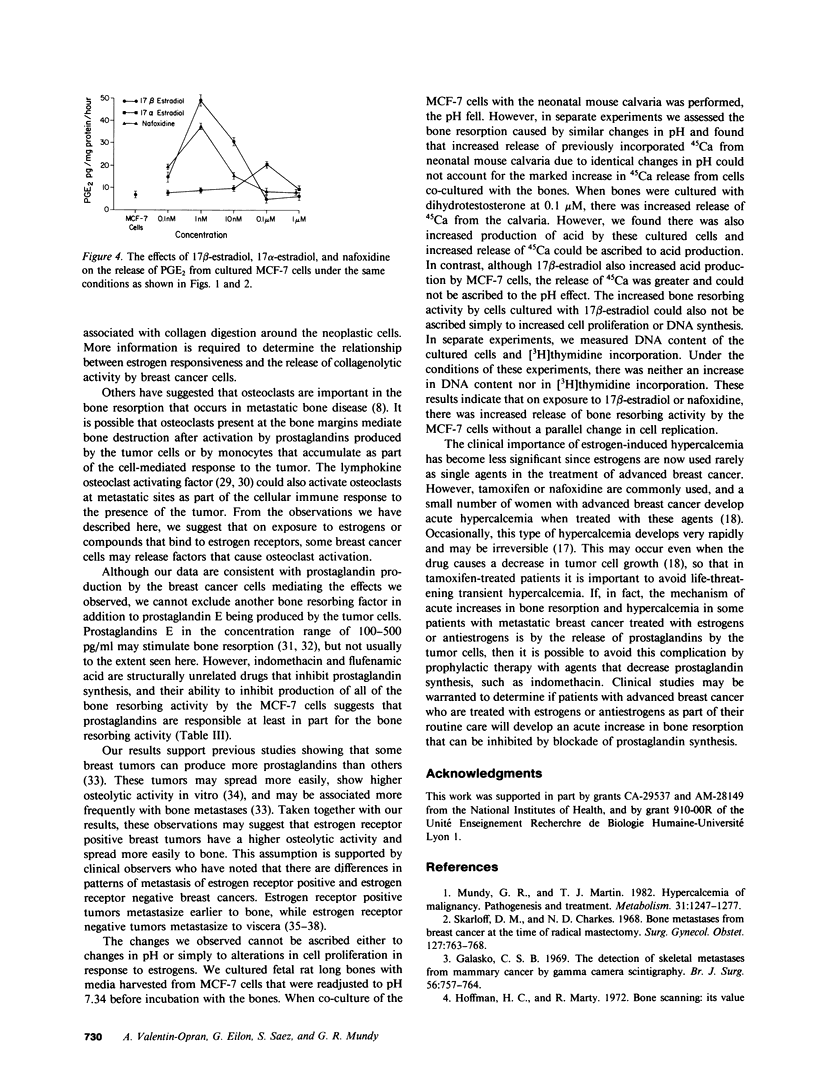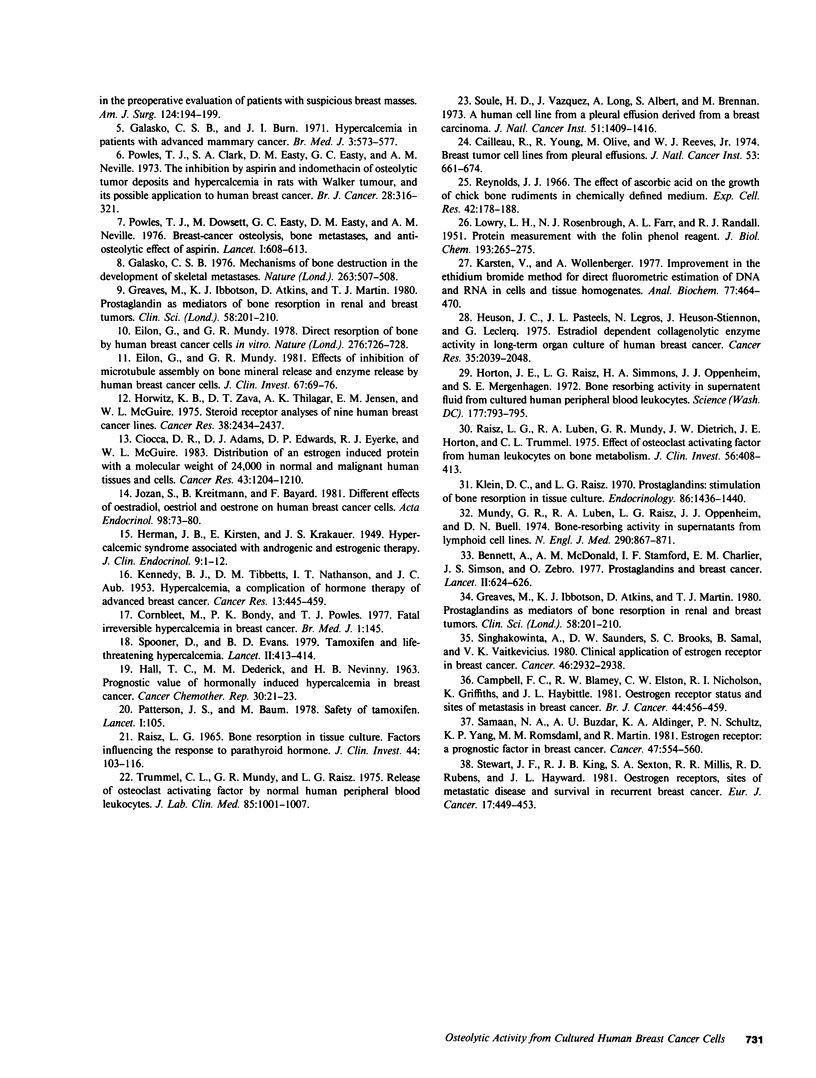Abstract
Patients with advanced breast cancer may develop acute, severe hypercalcemia when treated with estrogens or antiestrogens. In this study, we examined the effects of estrogens and related compounds on the release of bone resorbing activity by cultured human breast cancer cells in vitro. We found that the estrogen receptor positive breast cancer cell line MCF-7 releases bone resorbing activity in response to low concentrations of 17 beta-estradiol. Bone resorbing activity was also released in response to the antiestrogen nafoxidine. Other steroidal compounds had no effect on the release of bone resorbing activity. Estrogen-stimulated release of bone resorbing activity occurred with live bone cultures, but not with devitalized bones, indicating that the effect was bone cell mediated. The breast cancer cell line MDA-231, which does not have estrogen receptors, did not release bone resorbing activity in response to 17 beta-estradiol or nafoxidine. Release of the bone resorbing activity by MCF-7 cells incubated with 17 beta-estradiol was inhibited by indomethacin (10 microM) and flufenamic acid (50 microM), two structurally unrelated compounds that inhibit prostaglandin synthesis. Concentrations of 17 beta-estradiol and nafoxidine that caused increased release of bone resorbing activity by the breast cancer cells caused a four- to fivefold increase in release of prostaglandins of the E series by MCF-7 cells. These data may explain why some patients with advanced breast cancer develop acute hypercalcemia when treated with estrogens or antiestrogens, and why bone metastases are more common in patients with estrogen receptor positive tumors.
Full text
PDF





Selected References
These references are in PubMed. This may not be the complete list of references from this article.
- Bennett A., Charlier E. M., McDonald A. M., Simpson J. S., Stamford I. F., Zebro T. Prostaglandins and breast cancer. Lancet. 1977 Sep 24;2(8039):624–626. doi: 10.1016/s0140-6736(77)92496-5. [DOI] [PubMed] [Google Scholar]
- Cailleau R., Young R., Olivé M., Reeves W. J., Jr Breast tumor cell lines from pleural effusions. J Natl Cancer Inst. 1974 Sep;53(3):661–674. doi: 10.1093/jnci/53.3.661. [DOI] [PMC free article] [PubMed] [Google Scholar]
- Campbell F. C., Blamey R. W., Elston C. W., Nicholson R. I., Griffiths K., Haybittle J. L. Oestrogen-receptor status and sites of metastasis in breast cancer. Br J Cancer. 1981 Sep;44(3):456–459. doi: 10.1038/bjc.1981.205. [DOI] [PMC free article] [PubMed] [Google Scholar]
- Ciocca D. R., Adams D. J., Edwards D. P., Bjercke R. J., McGuire W. L. Distribution of an estrogen-induced protein with a molecular weight of 24,000 in normal and malignant human tissues and cells. Cancer Res. 1983 Mar;43(3):1204–1210. [PubMed] [Google Scholar]
- Cornbleet M., Bondy P. K., Powles T. J. Fatal irreversible hypercalcaemia in breast cancer. Br Med J. 1977 Jan 15;1(6054):145–145. doi: 10.1136/bmj.1.6054.145. [DOI] [PMC free article] [PubMed] [Google Scholar]
- Eilon G., Mundy G. R. Direct resorption of bone by human breast cancer cells in vitro. Nature. 1978 Dec 14;276(5689):726–728. doi: 10.1038/276726a0. [DOI] [PubMed] [Google Scholar]
- Eilon G., Mundy G. R. Effects of inhibition of microtubule assembly on bone mineral release and enzyme release by human breast cancer cells. J Clin Invest. 1981 Jan;67(1):69–76. doi: 10.1172/JCI110034. [DOI] [PMC free article] [PubMed] [Google Scholar]
- Galasko C. S., Burn J. I. Hypercalcaemia in patients with advanced mammary cancer. Br Med J. 1971 Sep 4;3(5774):573–577. doi: 10.1136/bmj.3.5774.573. [DOI] [PMC free article] [PubMed] [Google Scholar]
- Galasko C. S. Mechanisms of bone destruction in the development of skeletal metastases. Nature. 1976 Oct 7;263(5577):507–508. doi: 10.1038/263507a0. [DOI] [PubMed] [Google Scholar]
- Galasko C. S. The detection of skeletal metastases from mammary cancer by gamma camera scintigraphy. Br J Surg. 1969 Oct;56(10):757–764. doi: 10.1002/bjs.1800561017. [DOI] [PubMed] [Google Scholar]
- Greaves M., Ibbotson K. J., Atkins D., Martin T. J. Prostaglandins as mediators of bone resorption in renal and breast tumours. Clin Sci (Lond) 1980 Mar;58(3):201–210. doi: 10.1042/cs0580201. [DOI] [PubMed] [Google Scholar]
- Greaves M., Ibbotson K. J., Atkins D., Martin T. J. Prostaglandins as mediators of bone resorption in renal and breast tumours. Clin Sci (Lond) 1980 Mar;58(3):201–210. doi: 10.1042/cs0580201. [DOI] [PubMed] [Google Scholar]
- HALL T. C., DEDERICK M. M., NEVINNY H. B. PROGNOSTIC VALUE OF HORMONALLY INDUCED HYPERCALCEMIA IN BREAST CANCER. Cancer Chemother Rep. 1963 Jul;30:21–23. [PubMed] [Google Scholar]
- Heuson J. C., Pasteels J. L., Legros N., Heuson-Stiennon J., Leclercq G. Estradiol-dependent collagenolytic enzyme activity in long-term organ culture of human breast cancer. Cancer Res. 1975 Aug;35(8):2039–2048. [PubMed] [Google Scholar]
- Hoffman H. C., Marty R. Bone scanning. Its value in the preoperative evaluation of patients with suspicious breast masses. Am J Surg. 1972 Aug;124(2):194–199. doi: 10.1016/0002-9610(72)90013-x. [DOI] [PubMed] [Google Scholar]
- Horton J. E., Raisz L. G., Simmons H. A., Oppenheim J. J., Mergenhagen S. E. Bone resorbing activity in supernatant fluid from cultured human peripheral blood leukocytes. Science. 1972 Sep 1;177(4051):793–795. doi: 10.1126/science.177.4051.793. [DOI] [PubMed] [Google Scholar]
- Horwitz K. B., Zava D. T., Thilagar A. K., Jensen E. M., McGuire W. L. Steroid receptor analyses of nine human breast cancer cell lines. Cancer Res. 1978 Aug;38(8):2434–2437. [PubMed] [Google Scholar]
- Jozan S., Kreitmann B., Bayard F. Different effects of oestradiol, oestriol, oestetrol and of oestrone on human breast cancer cells (MCF-7) in long term tissue culture. Acta Endocrinol (Copenh) 1981 Sep;98(1):73–80. doi: 10.1530/acta.0.0980073. [DOI] [PubMed] [Google Scholar]
- KENNEDY B. J., TIBBETTS D. M., NATHANSON I. T., AUB J. C. Hypercalcemia, a complication of hormone therapy of advanced breast cancer. Cancer Res. 1953 Jun;13(6):445–459. [PubMed] [Google Scholar]
- Karsten U., Wollenberger A. Improvements in the ethidium bromide method for direct fluorometric estimation of DNA and RNA in cell and tissue homogenates. Anal Biochem. 1977 Feb;77(2):464–470. doi: 10.1016/0003-2697(77)90259-7. [DOI] [PubMed] [Google Scholar]
- Klein D. C., Raisz L. G. Prostaglandins: stimulation of bone resorption in tissue culture. Endocrinology. 1970 Jun;86(6):1436–1440. doi: 10.1210/endo-86-6-1436. [DOI] [PubMed] [Google Scholar]
- LOWRY O. H., ROSEBROUGH N. J., FARR A. L., RANDALL R. J. Protein measurement with the Folin phenol reagent. J Biol Chem. 1951 Nov;193(1):265–275. [PubMed] [Google Scholar]
- Mundy G. R., Luben R. A., Raisz L. G., Oppenheim J. J., Buell D. N. Bone-resorbing activity in supernatants from lymphoid cell lines. N Engl J Med. 1974 Apr 18;290(16):867–871. doi: 10.1056/NEJM197404182901601. [DOI] [PubMed] [Google Scholar]
- Mundy G. R., Martin T. J. The hypercalcemia of malignancy: pathogenesis and management. Metabolism. 1982 Dec;31(12):1247–1277. doi: 10.1016/0026-0495(82)90012-9. [DOI] [PubMed] [Google Scholar]
- Patterson J. S., Baum M. Safety of tamoxifen. Lancet. 1978 Jan 14;1(8055):105–105. doi: 10.1016/s0140-6736(78)90053-3. [DOI] [PubMed] [Google Scholar]
- Powles T. J., Clark S. A., Easty D. M., Easty G. C., Neville A. M. The inhibition by aspirin and indomethacin of osteolytic tumor deposits and hypercalcaemia in rats with Walker tumour, and its possible application to human breast cancer. Br J Cancer. 1973 Oct;28(4):316–321. doi: 10.1038/bjc.1973.154. [DOI] [PMC free article] [PubMed] [Google Scholar]
- Powles T. J., Dowsett M., Easty G. C., Easty D. M., Neville A. M. Breast-cancer osteolysis, bone metastases, and anti-osteolytic effect of aspirin. Lancet. 1976 Mar 20;1(7960):608–610. doi: 10.1016/s0140-6736(76)90416-5. [DOI] [PubMed] [Google Scholar]
- RAISZ L. G. BONE RESORPTION IN TISSUE CULTURE. FACTORS INFLUENCING THE RESPONSE TO PARATHYROID HORMONE. J Clin Invest. 1965 Jan;44:103–116. doi: 10.1172/JCI105117. [DOI] [PMC free article] [PubMed] [Google Scholar]
- Raisz L. G., Luben R. A., Mundy G. R., Dietrich J. W., Horton J. E., Trummel C. L. Effect of osteoclast activating factor from human leukocytes on bone metabolism. J Clin Invest. 1975 Aug;56(2):408–413. doi: 10.1172/JCI108106. [DOI] [PMC free article] [PubMed] [Google Scholar]
- Reynolds J. J. The effect of ascorbic acid on the growth of chick bone rudiments in chemically defined medium. Exp Cell Res. 1966 Apr;42(1):178–188. doi: 10.1016/0014-4827(66)90330-2. [DOI] [PubMed] [Google Scholar]
- Samaan N. A., Buzdar A. U., Aldinger K. A., Schultz P. N., Yang K. P., Romsdahl M. M., Martin R. Estrogen receptor: a prognostic factor in breast cancer. Cancer. 1981 Feb 1;47(3):554–560. doi: 10.1002/1097-0142(19810201)47:3<554::aid-cncr2820470322>3.0.co;2-w. [DOI] [PubMed] [Google Scholar]
- Singhakowinta A., Saunders D. E., Brooks S. C., Samal B., Vaitkevicius V. K. Clinical application of estrogen receptor in breast cancer. Cancer. 1980 Dec 15;46(12 Suppl):2932–2938. doi: 10.1002/1097-0142(19801215)46:12+<2932::aid-cncr2820461439>3.0.co;2-0. [DOI] [PubMed] [Google Scholar]
- Sklaroff D. M., Charkes N. D. Bone metastases from breast cancer at the time of radical mastectomy. Surg Gynecol Obstet. 1968 Oct;127(4):763–768. [PubMed] [Google Scholar]
- Soule H. D., Vazguez J., Long A., Albert S., Brennan M. A human cell line from a pleural effusion derived from a breast carcinoma. J Natl Cancer Inst. 1973 Nov;51(5):1409–1416. doi: 10.1093/jnci/51.5.1409. [DOI] [PubMed] [Google Scholar]
- Spooner D., Evans B. D. Tamoxifen and life-threatening hypercalcaemia. Lancet. 1979 Aug 25;2(8139):413–414. doi: 10.1016/s0140-6736(79)90423-9. [DOI] [PubMed] [Google Scholar]
- Stewart J. F., King R. J., Sexton S. A., Millis R. R., Rubens R. D., Hayward J. L. Oestrogen receptors, sites of metastatic disease and survival in recurrent breast cancer. Eur J Cancer. 1981 Apr;17(4):449–453. doi: 10.1016/0014-2964(81)90254-1. [DOI] [PubMed] [Google Scholar]
- Trummel C. L., Mundy G. R., Raisz L. G. Release of osteoclast activating factor by normal human peripheral blood leukocytes. J Lab Clin Med. 1975 Jun;85(6):1001–1007. [PubMed] [Google Scholar]


